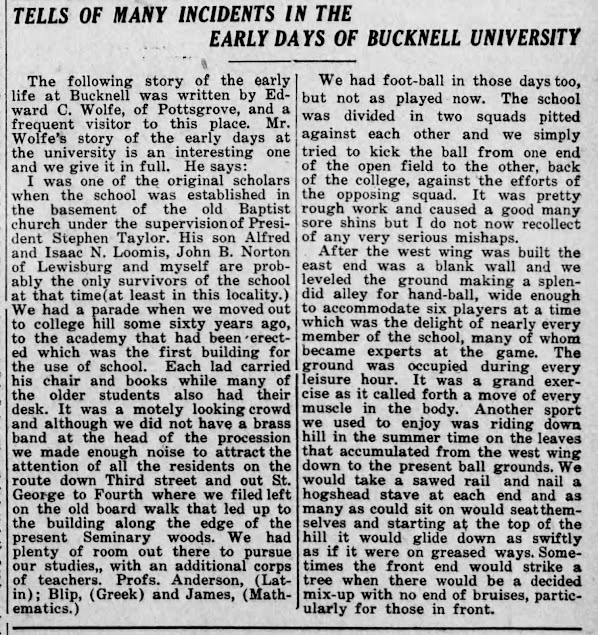 |
| The University Of Lewisburg, today Bucknell, 1870 |
In 1914, Edward Wolfe of Pottsgrove believed that he was likely only one of 4 local men still alive, who had attended Bucknell when it first began, in the basement of the Baptist church. He wrote of early life at the college, concentrating on the activities more than than the academics, with his recollections being published in the Lewisburg Journal in July of 1914.

As the Journal wrote, "Mr. Wolfe's story of the early days at the university is an interesting one and we give it in full":
The Early Days Of Bucknell University by Edward C. Wolfe, 1914
I was one of the original scholars when the school was established in the basement of the old Baptist church under the supervision of President Stephen Taylor. His son Alfred and Isaac N. Loomis, John B. Norton of Lewisburg and myself are probably the only survivors of the school at that time at least in this locality.
We had a parade when we moved out to college hill some sixty years ago, to the academy that had been erected which was the first building for the use of school. Each lad carried his chair and books while many of the older students also had their desk. It was a motely looking crowd and although we did not have a brass band at the head of the procession we made enough noise to attract the attention of all the residents on the route down Third street and out St. George to Fourth where we filed left on the old board walk that led up to the building along the edge of the present Seminary woods.
We had plenty of room out there to pursue our studies with an additional corps of teachers. Profs. Anderson, (Late in); Blip, (Greek) and James, (Mathematics.)
We had foot-ball in those days too, but not as played now. The school was divided in two squads pitted against each other and we simply tried to kick the ball from one end of the open field to the other, back of the college, against the efforts of the opposing squad. It was pretty rough work and caused a good many sore shins but I do not now recollect of any very serious mishaps.
After the west wing was built the east end was a blank wall and we leveled the ground making a splendid alley for hand-ball, wide enough to accommodate six players at a time which was the delight of nearly every member of the school, many of whom became experts at the game. The ground was occupied during every leisure hour. It was a grand exercise as it called forth a move of every muscle in the body.
Another sport we used to enjoy was riding down hill in the summer time on the leaves that accumulated from the west wing down to the present ball grounds. We would take a sawed rail and nail a hogshead stave at each end and as many as could sit on would seat themselves and starting at the top of the hill it would glide down as swiftly as if it were on greased ways. Some-times the front end would strike a tree when there would be a decided mix-up with no end of bruises, particularly for those in front.
============
More Of Bucknell's History
The first commencement at The University of Lewisburg was held on August 10 1851. Early commencements at the school were scheduled on the third Wednesday in August and were preceded by two days of examinations for the lower classes and a public exhibition of student work. A full schedule of activities would be held on the day of Commencement, ending with a dinner hosted by the President of the College, followed by a twilight concert.
At that first commencement in 1851, seven male students received Bachelors of The Arts degrees.
In 1867, escaped slave Charles Bell was walking through the area with an ax, returning from a visit to family. He was en route for Williamsport, where "hands were needed for lumber work". The University President, Justin Loomis spotted Bell, and hired him to chop down a tree. He then hired Bell as a janitor. Bell was employed by the University for over 40 years. Before his death in 1912, he recounted his escape from slavery, and it was published in the Lewisburg Journal. You can read that account here: https://susquehannavalley.blogspot.com/2020/02/charles-bell-escaped-slave-who-worked.htmlIn 1886, The Lewisburg University was renamed Bucknell in honor of William Bucknell, a major benefactor. His wife, Mrs Bucknell, sailed on the Titanic and lived to tell about it. You can read her story here: https://susquehannavalley.blogspot.com/2020/01/mrs-bucknell-sailed-on-titanic-and.html
READ MORE
==============
Founded in 1846 as the University at Lewisburg, Bucknell traces its origin to a group of Baptists who deemed it "desirable that a Literary Institution should be established in Central Pennsylvania, embracing a High School for male pupils, another for females, a College and also a Theological Institution."
The group's efforts for the institution began to crystallize in 1845 when Stephen William Taylor, a professor at Madison University (now Colgate) in Hamilton, N.Y., was asked to prepare a charter and act as general agent for the University's development.
The charter for the University at Lewisburg, granted by the Legislature of Pennsylvania and approved by the governor on Feb. 5, 1846, carried one stipulation — that $100,000 be raised before the new institution would be granted full corporate status. More than 4,000 subscribers ultimately contributed, including a small boy who gave 12 cents. - https://www.bucknell.edu/meet-bucknell/history-traditions













No comments:
Post a Comment
I'll read the comments and approve them to post as soon as I can! Thanks for stopping by!